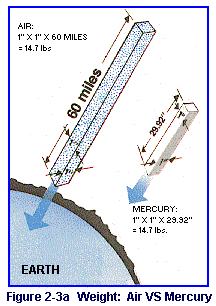 |
|||||
| Home | Research | For Teachers | HISTORY Level 1 Level 2 Level 3 |
PRINCIPLES Level 1 Level 2 Level 3 |
CAREER Level 1 Level 2 Level 3 |
| Gallery | Hot Links | What's New! | |||
| Web Administration and Tools | |||||
 |
|||||
| Home | Research | For Teachers | HISTORY Level 1 Level 2 Level 3 |
PRINCIPLES Level 1 Level 2 Level 3 |
CAREER Level 1 Level 2 Level 3 |
| Gallery | Hot Links | What's New! | |||
| Web Administration and Tools | |||||
![]()

The atmosphere extends upward for hundreds of miles. The pull of the Earth's gravity on air molecules (see figure 2-3a) as creates a pressure that pushes in all directions and amounts to about 14.7 pounds per square inch (psi) at sea level. This is air pressure on a standard day at sea level. This pressure will support 29.92 inches of mercury in a barometer, which is the instrument that provides the local atmospheric pressure that you hear on your daily television weather bulletins.
As you know, pressure changes take place at Earth's surface as high- and low-pressure cells form and move across the surface. However, changes in atmospheric pressure occur for aviators not only as they fly into or out of high- and low-pressure cells but also as they climb or descend in their airplanes. This is because atmospheric pressure changes with altitude (higher altitude - less pressure, lower altitude - more pressure).
Let us consider Earth's total atmosphere. We find that it extends from the surface outward into what we call space. As we travel outward (upward) there is less pressure because there are fewer air molecules above us. At 18,000 feet the pressure is about one-half as that at the surface. If we continue to travel outward, the pressure continues to reduce until there is no measurable pressure and, for all practical purposes, we are in space. Few aviators are concerned with high altitudes and consequent extreme low pressures, because the maximum operating altitude (ceiling) for most small air planes is 20,000 feet or less. Even at the relatively low altitude of 12,500 feet, pilots are required by regulation to breathe supplemental oxygen.
The factors of weight, density, temperature, and pressure of the atmosphere interact and one does not change without affecting the others. However, temperature change is the main reason the atmospheric pressure and density change. Let's look at how the temperature causes these changes. To do this, we must use a starting point and the accepted starting point is known as the standard atmosphere. The standard atmosphere is based on average conditions at 40° north latitude where the average pressure is 29.92 inches of mercury and the average temperature is 59° Fahrenheit (F) or 15° Celsius (C).
Under standard conditions, temperature decreases about 2° C or 3.5° F. for each 1,000-foot increase in altitude. Variations to this standard are common and the standard decrease is not always found. For example, what is called a temperature inversion may actually cause an increase rather than a decrease in temperature at some locations.

Temperature: ENERGY of motion.
Temperature also changes horizontally as well as vertically in the atmosphere (see figure 2-2b). How much it changes in any direction is partially based on the extent to which Earth's surface area is exposed to the Sun, our primary source of heat. The Sun's rays penetrate the atmosphere and heat Earth's surface, which in turn heats the atmosphere next to it. Atmospheric temperature is based on the amount of heat absorbed or reflected by the Earth's surface. Sand, water, and forested surfaces differ in the amount of heat they absorb and reflect so the air over them will be heated differently.

Pressure: Omnidirectional. FORCE of motion PER UNIT AREA.
The relationship of temperature to density and pressure can be confusing (see figure 2-3b). If a cubic foot of air on the Earth's surface is heated, the air will expand and rise in the atmosphere. This cubic foot of air may then occupy two cubic feet. Both its pressure and density will have decreased. As the air rises and expands, the heat it contains is spread over a larger area, and its temperature decreases with altitude. Also, as the air rises it receives less and less additional heat from the Earth's surface.
Send all comments to ![]() aeromaster@eng.fiu.edu
aeromaster@eng.fiu.edu
© 1995-98 ALLSTAR Network. All rights reserved worldwide.
| Funded in part by | From Civil Air Patrol Educational Materials |
Updated: 23 February, 1999